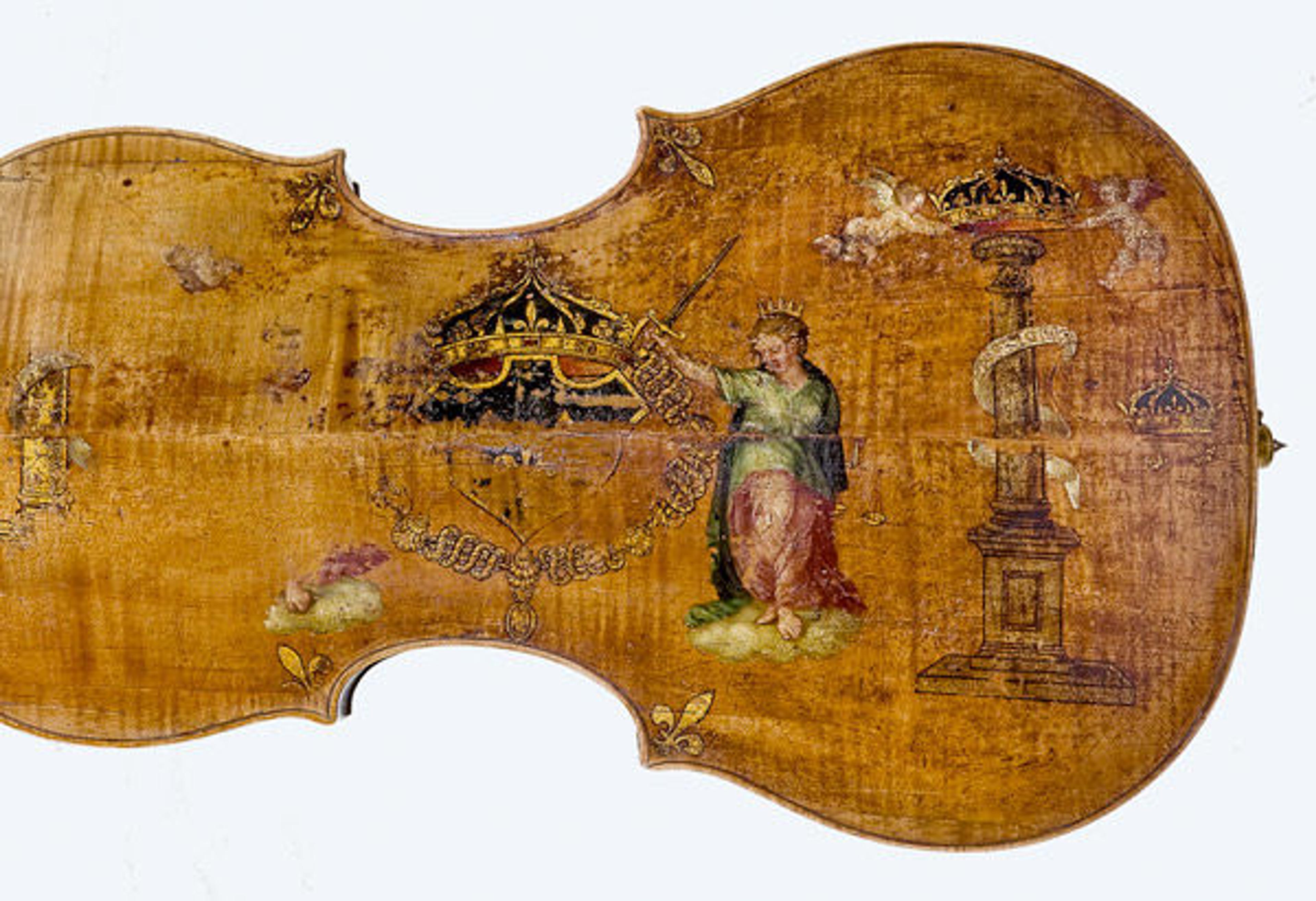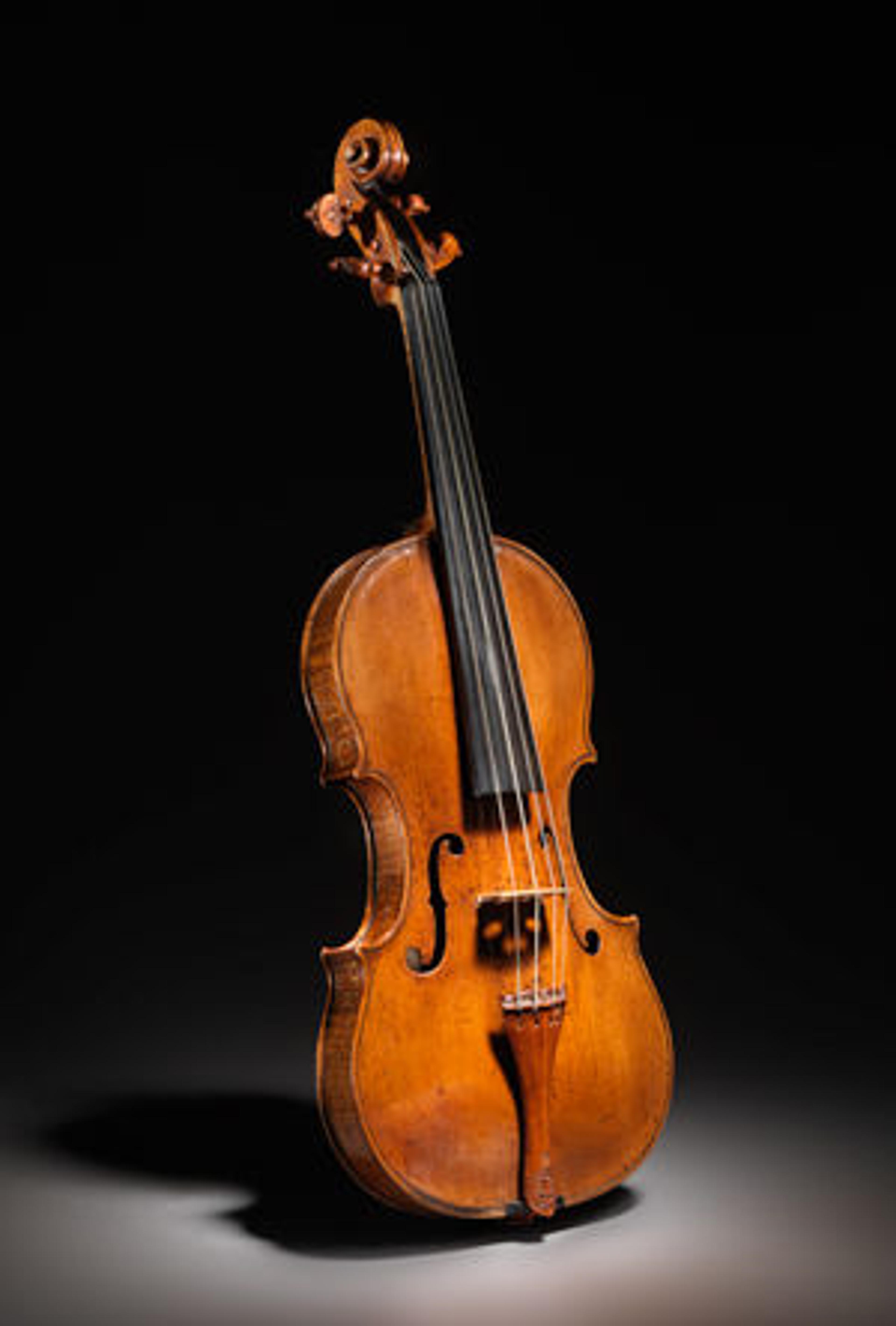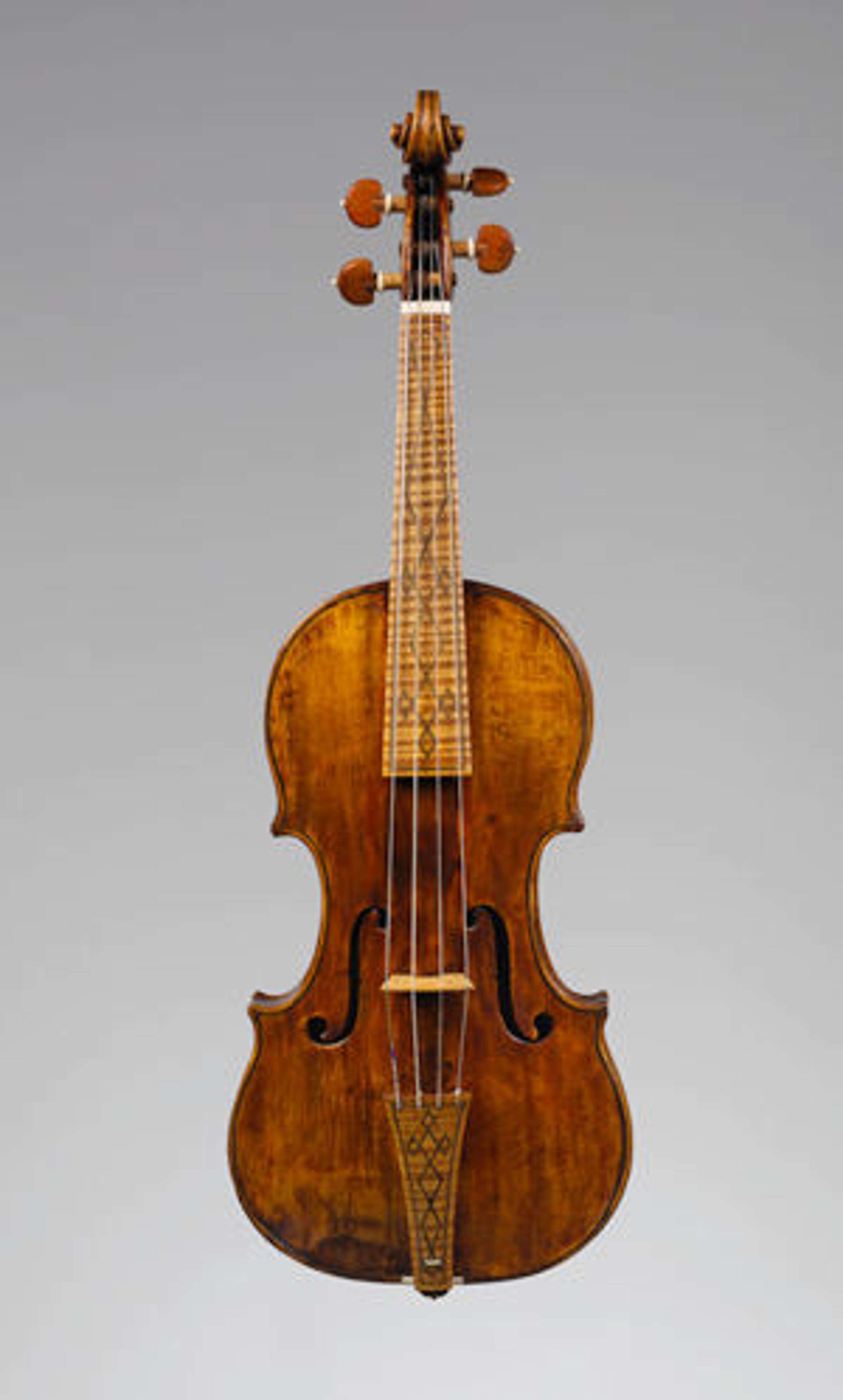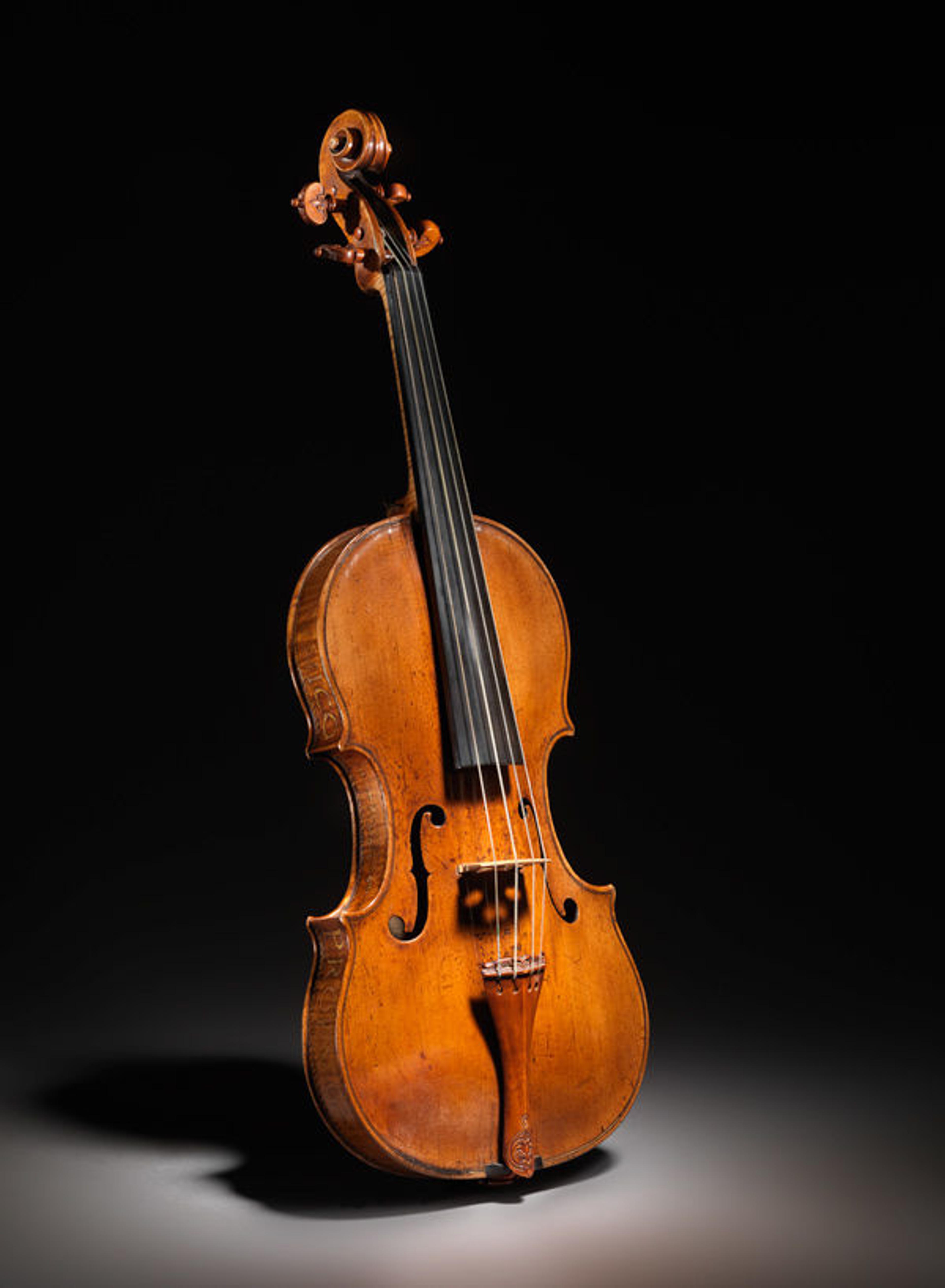
Andrea Amati (Italian, ca. 1505–1578). Violoncello, "The King" (detail), mid-16th century. National Music Museum, Vermillion, South Dakota, Witten-Rawlins Collection, 1984 (NMM 3351)
«The subject of exactly who was the "inventor" of the violin has swirled around the history of the craft of violin making for generations. While it may never be answered, what is indisputable is that Andrea Amati of Cremona created a style, design, and method of construction that was innovative, widely admired, and imitated throughout Europe in his lifetime, and thus it was Amati who established what the violin would become and what musicians all know and love to this day.»
While Amati's exact date of birth is not known, it has been triangulated by earlier scholars such as Carlo Bonetti to be about 1505. He is probably the Andrea liutaio who appeared in the household of Giovanni Leonardo de Martinengo in a military census of 1520, and by about 1525, might well have been working independently. Commercial success seems to have come fairly early for Amati; in February 1539, he was able to lease, and later buy, property in the center of Cremona—a house and workshop that would remain in his family's possession for another two hundred years.
Left: Andrea Amati (Italian, ca. 1505–1578). Ex-"Kurtz" Violin, ca. 1650. Italian (Cremona). Spruce, maple, ebony. The Metropolitan Museum of Art, New York, Purchase, Robert Alonzo Lehman Bequest, 1999 (1999.26)

Most of what we know of Andrea's early activity is based on anecdotal sources. Only the remnants of a viol and the "King" cello stand as witness to his endeavors. The notebooks of Count Ignazio Cozio di Salabue, mostly written during the 1810s, state that he had encountered several three-stringed violins by Andrea Amati that dated to the 1540s, the same period during which the "King" was created. That Cozio recognized them both as violins and as works by Amati is also significant in that it shows that Amati's style and concept were already distinctive and well formed.
The beginnings of what proved a long patronage by the French royal family are also uncertain. However, there is organological evidence, preserved in the National Music Museum in Vermillion, South Dakota, that it began early, perhaps around 1536, when Henry II became the heir to the French throne. The commission of the ensemble of instruments to which the "King" cello belonged was overseen by Henry's widow, Catherine de Medici, regent to her son, Charles IX, who inherited the throne in 1560 and whose coat of arms and motto appear on the "King" and its brethren from the Royal Ensemble.
The Charles IX commission was probably granted around 1561, not long after the young king was inaugurated, and appears to have been for a substantial number of instruments of various types. The French court was later famed for its string ensemble, Les Vingt-Quatre Violons du Roi, and presumably this was the group for whom they were intended. It would have required an enormous number of instruments, made according to a plan and consistency of design in order to function as a family. The scale of work, though, probably settled once and for all Andrea Amati's ideas of form and construction into the consistent and repeatable method violin makers adhere to today. Given the immense amount of work required, it is likely that the "King," which predates this commission, was adapted to the ensemble by the addition of the painted decorations (shown above), so as to save time.
In spite of this, the making of the Royal Ensemble probably occupied much of the workshop throughout the following decade, up to and perhaps beyond the death of Charles IX in 1574. Such a labor requires assistance, and in this Andrea could increasingly rely on the assistance of two sons: Antonio, who was probably born between 1537 and 1540, and Girolamo, probably born between 1550 and 1554. Other surviving Amati instruments point to continued patronage from nobility in France as well as in Spain, and that service to the French Court was continued by the family after Andrea's death on December 25, 1577.
The brothers worked together for a period of time after Andrea's death, but they parted company in 1588 and divided the workshop between them. Antonio continued working until his death, in 1607, but the family legacy rested with Girolamo, who continued working under both their names. Girolamo built upon their past successes to establish one of the premier musical-instrument workshops in Europe, one that boasted an international clientele, which resulted in the Amati violins traveling the continent and establishing the family model as the standard for instrument makers everywhere. Throughout this period, surviving instruments indicate that the Amatis' method was in-house—not shared with other workshops—so that they alone could produce such beauty.
Right: Nicolò Amati (Italian, 1596–1684). Violin, 1669. Cremona, Italy. Spruce, maple, other woods. The Metropolitan Museum of Art, New York, Gift of Evelyn Stark, 1974 (1974.229 a-d)

Girolamo also produced something every bit as important to the Amati name: an heir to the family tradition. His son, Nicolò (1596–1684), was his successor, raising the shop to even greater heights and creating violins of exquisite beauty. When Girolamo died during the plague of 1630, his workshop was left in the most capable of hands of his son, and Nicolò is still regarded as one of the supreme craftsmen ever to make violins. Yet, ironically, it was that success that proved the family's undoing. Orders must have still come in during the years after the plague, and at some stage Nicolò, who married late, must have needed assistance, which he then took from a few local and several foreign families. The result was that all of these new luthiers eventually went their separate ways, taking with them the Amati method and permanently breaking the family's monopoly. The dissolution of the Amati house then opened the door for the Guarneri family, as well as a talented youth from the neighborhood, Antonio Stradivari.
Related Links
Of Note—Now on View: Andrea Amati's "King" Cello, on Loan from the National Music Museum
Heilbrunn Timeline of Art History—Violin Makers: Nicolò Amati (1596–1684) and Antonio Stradivari (1644–1737)
